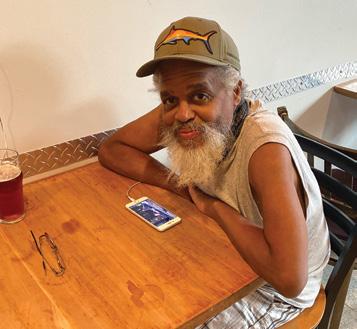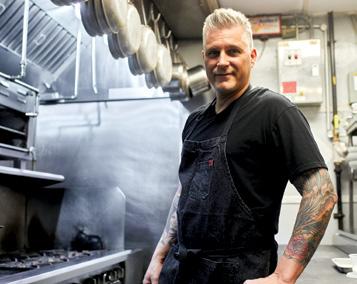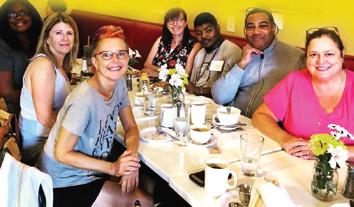
NEWS
4 The last call for Durham bar scene stalwart Marlon Williams.
 BY THOMASI MCDONALD
BY THOMASI MCDONALD
6 The stakes are high as Moore v. Harper goes before the U.S. Supreme Court this week.
BY JASMINE GALLUP
8 The state is appealing a judge's ruling ordering it to provide home-based services to NC residents with intellectual and developmental disabilities.
BY ANNE BLYTHE
ARTS & CULTURE
10 Durham musician Mimi Luse takes an exhilarating turn to industrial techno as Permanent.
BY BRIAN HOWE
12 Noah Baumbac's adaptation of White Noise is a carefully calibrated blend of deadpan humor and affectionate satire. BY GLENN MCDONALD
14 Will the Triangle's new social districts drive foot traffic—and revenue?
BY SARAH EDWARDS
16 "We just want to help people experience what we fell in love with— that beautiful simplicity," Scott Crawdord says of the Croatian-Italian cuisine behind his new restaurant, Brodeto. BY LENA GELLER
18 An interview with director Rebecca Holderness about her Burning Coal production of the cerebral Silent Sky
BY BYRON WOODS
COVER Queeny's employee Maximus LeBoy serves to-go drinks to customers.
BRETT
email and cost “Re: “No free-roaming ing well the U.S. threat-birds-previously-thought). applaud recount
“If you the American vide information ents a org/case-indoor-cats).” Last of the communities welcome about says she in the “I was don’t remember ANNE should the ‘faith’ Finally, ery Barrel doors. but some always “Living tasting “Yep. “They BRYAN tal stuff. We five-year
WANT indyweek.com @INDYWeekNC
2 December 7, 2022 INDYweek.com
B A C K T A L K
CONTENTS Raleigh W Durham W Chapel Hill VOL. 39 NO. 49
PHOTO BY
VILLENA / DESIGN BY NICOLE PAJOR MOORE
The NCMA hosts Black Nativity in Concert on Saturday, December 10. (See calendar, page 20.)
W E M A D E T H I S PUBLISHER John Hurld EDITORIAL Editor in Chief Jane Porter Managing Editor Geoff West Arts & Culture Editor Sarah Edwards Staff Writers Jasmine Gallup Thomasi McDonald Lena Geller Copy Editor Iza Wojciechowska Interns Chad Knuth, Lia Salvatierra Nathan Hopkins Contributors Spencer Griffith, Brian Howe, Kyesha Jennings, Jordan Lawrence, Glenn McDonald, Nick McGregor, Gabi Mendick, Shelbi Polk, Dan Ruccia, Rachel Simon, Byron Woods CREATIVE Creative Director Nicole Pajor Moore Graphic Designer Izzel Flores Staff Photographer Brett Villena ADVERTISING Publisher John Hurld Sales Digital Director & Classifieds Mathias Marchington CIRCULATION Berry Media Group MEMBERSHIP/ SUBSCRIPTIONS John Hurld INDY Week | indyweek.com P.O. Box 1772 • Durham, N.C. 27702 Durham 320 East Chapel Hill Street, #200 Durham, N.C. 27701 | 919-286-1972 Raleigh: 16 W Martin St, Raleigh, N.C. 27601 EMAIL ADDRESSES first initial[no space]last name@indyweek.com ADVERTISING SALES advertising@indyweek.com Raleigh 919-832-8774 Durham 919-286-1972 Classifieds 919-286-6642
© 2022 ZM INDY, LLC
rights reserved. Material may not be reproduced without permission. THE REGULARS 3 Backtalk/Op-Ed 20 Culture Calendar
PHOTO COURTESY OF NCMA
Contents
All
“Re: Of Mice and Meows, Nov 16, 2022
“No matter how we characterize the wonderfulness of cats, free-roaming cats—both feral and owned—are responsible for kill ing well over a billion birds and small native mammals each year in the U.S. alone (https://www.audubon.org/news/cats-pose-even-biggerthreat-birds-previously-thought). Just keep that in mind, please, as you applaud programs that release feral cats (TNRs) or enthusiastically recount your roaming cat’s charms.
“If you are interested in the impact of free-roaming cats on birds, both the American Bird Conservancy and the National Audubon Society pro vide information on the subject. The Wildlife Center of Virginia pres ents a strong case for keeping cats indoors (https://www.wildlifecenter. org/case-indoor-cats).”
Last week for print, Thomasi McDonald wrote about the return of the Children’s Defense Fund’s Freedom Schools to Durham communities this summer after a three-year pause. While it’s a welcome return for a program that teaches school-age children about the importance of social justice, a Facebook commenter says she has reservations about the role of faith-based groups in the program.
“I was at a CDF presentation about Freedom Schools years ago, and don’t remember religious groups being a part of the program,” wrote ANNE HAVISHAM on Facebook. “That’s not to say that churches should not be involved, but it strikes me as unnecessarily divisive that the ‘faith’ in ‘faith-based’ requires anything other than faith in Justice.”
Finally, for the web, Lena Geller wrote about Durham brew ery Barrel Culture Brewing and Blending’s decision to close its doors. The brewery championed imaginative fruit-forward beers, but some readers say, ultimately, regular old beer-flavored beer is always going to win the day.
“Living proof that at the end of the day, most of us just want a normal tasting beer,” wrote commenter JESÚS GUTIÉRREZ on Facebook.
“Yep. Regular beer. ,” agreed commenter SANDRA FLEMING
“They made plenty of ‘normal’ beers,” responded commenter BRYAN RODGERS. “They were just more known for the experimen tal stuff. Many factors led to the decision to close, not just the beers.”
We at the INDY will miss Barrel Culture and applaud them for a five-year run.
Democracy Won
Americans did their part to preserve democracy by turning out to vote; it’s time for the U.S. Justice Department to do its job and prosecute Donald Trump.
BY BOBBIE RICHARDSON backtalk@indyweek.com
In November, voters across the country and here in North Carolina finally got the chance to exercise one of our most fundamental rights: the right to vote. For months, pundits and the political class told us that people wouldn’t turn out to defend our rights, like access to reproductive rights and the right to choose who leads us. MAGA Republicans campaigned across North Carolina to take away those rights, con fident that they would triumph, have a decisive vic tory and overwhelming mandate in the House, and take back the Senate. And most egregiously, many of them campaigned on taking away our right to choose who leads us, supporting former president Trump in his criminal conspiracy to overturn the results of the 2020 election.
But Americans proved them all wrong. Democracy was on the ballot, and democracy won. November 8 showed that when Americans under stand that our freedoms are under threat, we act decisively to protect them. North Carolinians saw the election as a choice between freedom and extremism and voted for freedom.
We heard the antidemocratic message from Trump and MAGA Republicans and rejected them. We saw that MAGA Republicans and election deniers contin ued to not only push false claims about the 2020 election but also pose threats to future elections, the future of democracy, and many of our most fun damental rights and freedoms.
Exit polls show Americans focused on democracy and protecting their rights to abortion care as moti vating factors for heading to the polls. Americans rejected Trump and MAGA Republicans’ dark and divisive view of the country and voted for freedoms: the freedom to choose our own leaders, the freedom to access abortion and make other decisions about our health, and other freedoms promised by the Constitution. More than two-thirds of voters said democracy in the United States was threatened. And a majority of voters said abortion should be legal in all or most cases.
In North Carolina, Democrats defeated January
6 participant Sandy Smith and Trump protégé Bo Hines in toss-up House races. While those victories should be heartening to anyone who cares about democracy, the threats are far from over. North Car olinians chose election denier Ted Budd to serve in the U.S. Senate, and voters elected a conservative majority to the state supreme court. These losses are devastating for our democracy, but we must not grow weary. Our democracy is worth fighting for, and we will never give up on it.
Every member of the Republican leadership of the 118th Congress and at least 159 members of the incoming Republican House majority are elec tion deniers, including at least three new members who personally participated in protests at the Cap itol on January 6. MAGA Republicans have made it clear that instead of solving the kitchen table issues that Americans care about, they will do everything in their power to wage a political war against Pres ident Biden and Democrats. They will continue to do whatever they can to take away the rights we all fought for on November 8.
And their leader, former president Trump, has a wide swath of criminal investigations, both into his business and into his own conduct. So far, he hasn’t faced any sort of accountability for his actions.
At every turn, Trump has attempted to avoid accountability and prosecution for these many crimes. In Donald Trump’s decades of public life, he’s lied, cheated, stolen, and even incited violence, skirting accountability at almost every turn. This has gone on long enough. No one is above the law, not even former presidents. The response to Trump from the courts must be clear: running for president is not a get-out-of-jail-free card. The courts must hold Trump and his co-conspirators accountable for their crimes. The American people did our part. It’s time for the Department of Justice and the Judicial Branch to do theirs. W
INDYweek.com December 7, 2022 3
O P - E D
Bobbie Richardson is the chair of the NC Democratic Party.
A couple of weeks ago, Jasmine Gal lup wrote about an Orange County program that is giving feral cats in the area “work” as barn cats in order for them to be able to continue to live healthily in outdoor settings. But one reader, BETTY ANNE B., wrote us an email entitled “Of Dead Birds and Meows” and argued that the program comes at a cost for other wildlife.
C K T A L K WANT TO SEE YOUR NAME IN BOLD?
@INDYWeekNC @indyweek
B A
indyweek.com backtalk@indyweek.com
Marlon’s Last Song
Durham locals remember Marlon Williams, a beloved fixture of the city’s downtown bar scene.
 BY THOMASI MCDONALD tmcdonald@indyweek.com
BY THOMASI MCDONALD tmcdonald@indyweek.com
The world needs more bar characters.
Marlon Arrington Williams, with his trademark flowing gray whiskers, owl ish Windsor glasses, and easygoing gaptoothed grin, was an habitué at a handful of bars in Durham’s downtown district.
Williams often sat at the end of bar counters, sipping from a glass of his favor ite beer or whiskey while reading or watch ing the soap operas he loved. The more polished spots like Kingfisher, Unscripted, and the Pour House weren’t his scene. He preferred rustic, dark-paneled rooms with dim lighting and a pub-like ambience served up at the Accordion Club, Bull McCabe’s, 106 Main, Bull City Burger and Brewery, and the James Joyce.
It seems almost prescient now: on a warm, sunny early Monday afternoon before Thanksgiving, Williams, a normally reserved and quiet man, was the body electric while holding court at the dive bar Accordion.
Grinning like he had gotten away with something, which we will soon see he had, Williams stood in the middle of the bar with his right arm draped around a bar tender while singing Journey’s 1983 hit “Separate Ways (Worlds Apart).” Shoot, he even did a little soft-shoe dance and played the air guitar.
Someday love will find you Break those chains that bind you
One night will remind you How we touched and went our separate ways.
The next night, on November 22, Wil liams returned to Accordion. It was just after nine p.m. when he collapsed and died while talking to a bartender.
He was 62.
“Isn’t that crazy, that he would sing that song?,” says Juliette Cash, an Accordion bartender who was working the Monday when Williams sang one last take of “Sep arate Ways.”
Before arriving for his ultimate last round at Accordion, Williams had stopped by the James Joyce on Main Street for dinner around seven.
“He and a friend split a sandwich,” Pete Bolduc, who was working behind the James Joyce bar that night, told the INDY. “He went to the Accordion for a nightcap.”
Bolduc could only shake his head think ing about the trauma endured by Accor dion workers who saw what happened to Williams.
“I have a bad night if there’s a fight or someone throws up,” he says. “It’s hard to process. It’s just so unreal to see someone at night in relative perfect health, then wake up the next morning and they’re gone.”
Williams’s cause of death has not official ly been made public.
The day after Williams died, Accordion was closed.
“We never close. But we closed for that one,” one of the Accordion bartenders told the INDY.
Accordion workers weren’t the only ones shaken by Williams’s death. A goodly num ber of bartenders and barflies alike in the downtown district were shocked and sad dened by the news of Williams’s passing.
My friend and fellow journalist Eric Tullis currently bartends at Unscripted but poured many a draft for Williams while working at the old Whiskey and Cri terion bars. He texted me the Wednesday before Thanksgiving.
“Marlon had a heart attack last night at the Accordion,” Tullis’s text read.
I called him immediately.
“How is he?” I asked.
“He’s dead,” Tullis answered.
Over at 106 Main, there’s an empty chair where Williams used to sit near the end of the bar. Three bouquets of flowers in glass vases sit atop the section of bar where he would be, hunched over a drink and a news paper. Several glass-encased burning candles are on one side of the flowers. Two empty shot glasses and an unopened orange-andgray can of Williams’s favorite beer, Belle’s
Two Hearted Ale, sit on the other.
There’s a small, gold-plated plaque about the size of a business card on the counter. It reads “Forever Corporate, Marlon A. Wil liams: The Academy Thanks You.”
Alise Leslie, a bartender at 106 Main, says Williams was known as “Corporate” because he was one of the bar’s first cus tomers when it opened several years ago.
“We would say, ‘Talk to Corporate,’” Les lie explains about how the staff humorous ly dealt with minor issues if Williams was seated at the bar. “It was one of those 106 inside jokes.”
The 106 Main staff also put out a yel low legal pad with “Thoughts of Marlon” scrawled across the top for bar patrons to sign. As of Monday, more than 35 people had written tributes.
“I will miss your laugh,” someone wrote. “Your witness and strength, you sexy moth erfucker. Rest in Peace.”
“What will NFL Sundays at 106 be like without you now? Miss you already.”
“Marlon, you were kind. You spoke to me like I was a person and not a stereotype.”
Marlon Arrington Williams was born in 1960. He was a descendant of one of Cary’s most prominent and pioneering
4 December 7, 2022 INDYweek.com N E W S Durham
Marlon Arrington Williams
PHOTO BY LENA GELLER
families of overachievers dating back to the antebellum South.

Williams’s great-great-grandfather, Alfred Arrington, was the son of an enslaver on a plantation in Warren County. He was freed before the Civil War and came to Cary during the late 1860s. Alfred and his son, Arch Arrington, were large landowners in north central Cary, according to the Friends of Page Walker website.
The website notes that Williams’s grand father Arch Arrington Jr. organized an effort to build a new school for Black children in 1937 after the Cary Colored School near the present day Cary Elementary School burned down. Williams’s uncle Goelet Arrington donated land to the Wake County Public School System for the school. It went on to become Kingswood Elementary School.
Williams’s family could not be reached for comment, and the INDY found scant infor mation about his father. Williams was the only child of Ella Arrington Williams-Vin son, a Wake County public elementary school teacher and author of Both Sides of the Tracks, two volumes chronicling Cary’s racial history. She taught for more than three decades and died in 2013.
After graduating from high school, Wil liams earned an undergraduate degree in economics from Notre Dame in 1982, an official with the school’s registrar’s office told the INDY. Williams earned a law degree from the UNC-Chapel Hill School of Law, according to the website lawyers.com.
Williams hadn’t lost a case in nearly 20 years. But that’s because he hadn’t repre sented anyone in nearly 20 years, according to the California and North Carolina state bar associations.


Williams was admitted to the State Bar of California on September 16, 1987. But his license to practice law in that state was suspended on September 16, 2004, after he failed to pay his bar fees, according to the state bar’s website.
He had an online presence that indicated he operated a law office at 916 West Trinity Street, but his name or status as an attor ney does not appear during a search of the NC State Bar Association website. Nor does he appear in a search for paralegals on the bar association’s website.
“He did legal work,” Leslie, the bartender at 106 Main, told the INDY. “He didn’t have an office. He did title searches and that sort of thing. He didn’t litigate.”
Bolduc, at the James Joyce, wasn’t sure if Williams had passed the bar.
“I know he was a paralegal,” Bolduc told the INDY. “Maybe he was an attorney. He would come in here and do a bunch of briefs and technical writing.”
“He often brought his work here,” says
Cash, at Accordion. “Sometimes he would fin ish beforehand, but if not, he’d bring it here.”
But even if he ran into financial difficul ties that pretty much flatlined his status with the state bar for nearly two decades, those who served him drinks and food while exchanging heaping slices of good-natured banter could care less. They don’t measure him by whether he had passed the state bar but by the largeness of his heart that he shared while sitting at their bar counters.
The downtown bartenders who served Williams fondly remember a quick-witted, very direct person who didn’t mince words. He was highly intelligent, very observant, and capable of “being very, very silly,” Leslie says.
“He would come in and watch the soap operas on his phone or the TV,” Leslie adds. “He would watch The Young and the Rest less and The Bold and the Beautiful.”
Sometimes, he would watch his soaps at Accordion.
“The Young and the Restless came on at 12:30 p.m. and The Bold and the Beautiful came on right after that,” Cash says. “He’d watch them back to back.”
Cash adds that Williams was a very private person. A mutual friend, Allen Redd, agreed.
“He was a tough old nut to crack,” Redd told the INDY.

Taj Snead, the front house manager at Bull City Burger and Brewery on Parrish Street, told the INDY that Williams would drop by every once in a while and have a seat at the end of the bar.
“He would read,” Snead says. “He would bring a newspaper or a book and order a burger and a beer.”
Cash says the week before Williams died, he arrived at Accordion soon after the start of her shift at 11 a.m.
“He drank all day and kept making song requests,” she says. “I told him I would play whatever he wanted me to play. He loved the Talking Heads and Journey. He was drinking Narragansett that week.”
Long before that fateful Tuesday night at Accordion, Williams had easily passed the highest bar of all: people genuinely cared about him.
“Marlon, I have seen your smile for years and it always lit up a room,” someone wrote on the yellow legal pad at 106 Main. “So many people love you.”
A memorial service for Williams will take place at 12 p.m. Saturday, December 10 at the Burthey Funeral Chapel, 1510 Fayetteville Street. A celebration of his life will take place at the Accordion Club immediately following the service.
Wka e up with us
INDYweek.com December 7, 2022 5
news, events and more— in your inbox every weekday morning Sign up: indyweek.com/newsletter-signup
DAILY
Local
INDY
SIGN UP FOR THE
A Consequential Case
North Carolina lawmakers argue that state legislatures shoud have sole authority over redistricting, without input from the courts, in a case that will have massive implications for U.S. elections. Will the Supreme Court agree?
 BY JASMINE GALLUP jgallup@indyweek.com
BY JASMINE GALLUP jgallup@indyweek.com
After fending off the Republican-dominated state leg islature for more than a decade, voting rights advo cates are arguing their case before the U.S. Supreme Court Wednesday.
Moore v. Harper, a North Carolina case that was appealed to the nation’s highest court earlier this year, is the culmi nation of a more-than-10-year battle over voting rights, particularly the rights of Black and brown voters. It’s a battle to make your vote count.
Back in 2011, when Republicans took control of the state legislature, they immediately began the process of gerrymandering—drawing the boundaries of electoral dis tricts in favor of their own political party—so they could stay in power.
“They drew districts that packed as many Black vot ers into as few districts as possible, limiting their political power,” says Allison Riggs, co–executive director and chief counsel for voting rights at the Southern Coalition for Social Justice (SCSJ). Riggs is one of the lawyers arguing in
favor of voters before the Supreme Court this week.
“[The legislature was] drawing these district lines based on race and then also creating partisan gerrymanders—dis tricts that would not be responsive to the political will of North Carolina voters,” Riggs says.
The unfair voting map North Carolina Republicans approved was just the first law of many that would be challenged in court. Over the next 10 years, Republicans continued to try to pass racial and partisan gerrymander ing plans, most of which were struck down after challenges from SCSJ and other voting rights groups.
In 2013, North Carolina legislators passed a law that would have “cut early voting, eliminated precinct voting, and placed restrictive voter ID requirements,” says Tyler Daye, policy and civic engagement manager at Common Cause NC. The effort, which would have widely disenfranchised Black and brown voters, made national headlines.
A three-judge federal appeals panel in 2016 struck
down the law, calling it “the most restrictive voting law North Carolina has seen since the era of Jim Crow” and one that “targeted African Americans with almost surgical precision.”
The movement to enact voting restrictions, making it harder to vote early, vote by mail, or vote at all if you’re a minority, surged after the 2020 presidential election, with extreme conservatives crying “voter fraud” as Joe Biden defeated Donald Trump.
These are the kinds of laws—ones that disproportion ately affect young voters and voters of color—that Repub licans could bring back if they win in the Moore v. Harper case, says Daye.
“And the question is, would there be a check on the state legislature’s power?” Daye says. “This case is really, truly vital to our democracy. It’s not a Democratic or Republican issue. It’s about all of our voting rights. No single branch of government should have unchecked power.”
The legalities
One reason Moore v. Harper is getting so much atten tion is that it’s different from the redistricting cases that have been argued in North Carolina before. Unlike previous cases, Moore doesn’t address a single voting map or law. Instead, it covers the wider question of how much auton omy state legislatures should have over redistricting and election laws.
“It goes beyond just redistricting,” Daye says. “We could be talking about federal elections law.”
Last year, following the decennial census, the bat tle over redistricting again came into the spotlight. The Republican-led legislature passed gerrymandered voting maps, and SCSJ challenged them in court. Vot ing rights advocates won the case in the NC Supreme Court, but unlike with previous cases, their battle didn’t stop there.
In June, the U.S. Supreme Court voted to take up the case, despite a previous 2019 ruling saying partisan gerry mandering should be handled by state courts. And Republi
6 December 7, 2022 INDYweek.com N E W S North Carolina
VIA
SUPREME COURT BUILDING PHOTO BY KJETIL REE
WIKIMEDIA COMMONS
cans are taking full advantage of the oppor tunity to make their case heard before the nation’s nine justices.
In Moore, the NC GOP is arguing that state lawmakers should have almost com plete power over elections. They argue that state courts have no constitutional authority to strike down election laws and impose new ones, as they have in the past.
“That is what is so concerning, because if state legislatures have that sort of unchecked power, you’re giving a signif icant amount of power to one branch,” Daye adds. “No matter what party you’re a part of, you don’t want one party to have that type of unfettered power.”
The Republican argument is founded on the “independent state legislature theory,” a belief that “state legislatures—and only state legislatures—have the power to regulate fed eral elections in their states, irrespective of the constraints imposed by state constitu tions or the efforts of state courts to enforce state laws,” says Asher Hildebrand, an associ ate professor at Duke University’s Sanford School of Public Policy.
“This radical theory has no basis in history, no basis in legal prec edent, and no basis in common sense,” Hil debrand adds. “The fact that the Supreme Court is even consid ering it says far more about the extremism and diminishing credi bility of the court than it does about the merits of the theory.”
During the exchange of written legal arguments, Republicans have at times suggested the court should overrule major precedents that have favored balance and oversight in redistricting, says Riggs.
That includes the right of voters to strike down a redistricting plan through referendum (1916’s Davis v. Hildebrant); the power of state governors to veto redis tricting maps (1932’s Smiley v. Holm); and voters’ rights to create an independent redistricting commission (2015’s Arizona State Legislature v. Arizona Independent Redistricting Commission).
“[The] petitioners’ brief talks about the history of the elections clause, and they make it seem like this is an unfet tered power that the framers gave to the state legislators, to the exclusion of all others and ignoring the traditional and historic underpinning of judicial review,” Riggs says.
The future
SCSJ’s defense of voting rights has received broad bipartisan support from lawyers, jurists, scholars, commentators, and others who have filed amicus curiae, or “friend of the court,” briefs in their favor, says Riggs. Notable participants include former California Republican gov ernor Arnold Schwarzenegger and other former Republican officials, the American Bar Association, and the American Civil Liberties Union.
The outcome of the case is far from guar anteed, however. Even if the U.S. Supreme Court rules in favor of the respondents (SCSJ and others), battles over redistrict ing will continue, Riggs says.
“Whenever we won in a courtroom, those who have been committed to drawing redis tricting lines to disempower rather than empower have found new ways,” she says.
“Even if we get that pos itive outcome, it means we go back to state courts. There will be more work to be done, but at least we will know that state con stitutions will do what they’re meant to do.”
The decision of the U.S. Supreme Court, like ly to be released some time next year, will lean on today’s oral argu ments, including the exchange of questions and answers between justices and attorneys.
Thanks to Trump’s appointment of three new justices, the U.S. Supreme Court has a solid 6-3 conser vative majority. A ruling in favor of Repub licans could have significant consequences for voters, particularly those of color.
“We’ve seen Black and brown voters being targeted because of their race and for polit ical reasons. And we’ve seen this justified as ‘It’s politics, not race,’ or ‘We’re just complying with the Voting Rights Act.’ [But] the South ern strategy is still alive and well, and we, as racial justice advocates, have to continue to call out and name that impact,” Riggs says.
“This is part of a larger story arc of North Carolina voters bucking under the restrictions of redistricting plans that are designed to polarize, separate, limit politi cal power for some, and maximize political power for others. It’s part of a build-up to the ultimate question: How do voters get relief when the people that they’re electing are redrawing their own lines to secure their own futures?” W
RECYCLE THIS PAPER RECYCLE THIS PAPER RECYCLE THIS PAPER RECYCLE THIS PAPER RECYCLE THIS PAPER RECYCLE THIS PAPER RECYCLE THIS PAPER RECYCLE THIS PAPER RECYCLE THIS PAPER RECYCLE THIS PAPER RECYCLE THIS PAPER RECYCLE THIS PAPER RECYCLE THIS PAPER RECYCLE THIS PAPER RECYCLE THIS PAPER RECYCLE THIS PAPER RECYCLE THIS PAPER RECYCLE THIS PAPER RECYCLE THIS PAPER RECYCLE THIS PAPER RECYCLE THIS PAPER RECYCLE THIS PAPER RECYCLE THIS PAPER
Visit INDYWeek.com for restaurant reviews and food & drink news.

INDYweek.com December 7, 2022 7
Hear about that great new BBQ place.
“This radical theory has no basis in history, no basis in legal precedent, and no basis in common sense.”
A Long Time Coming
A superior court judge ordered the state to comply with a ruling to provide home services to 16,000 residents with intellectual and developmental disabilities. North Carolina’s health agency is appealing the decision.
BY ANNE BLYTHE backtalk@indyweek.com
F our weeks after a state superior court judge issued a far-reaching ruling order ing North Carolina to deliver services in home settings to people with developmen tal and intellectual disabilities, the state is appealing the decision.
Kody Kinsley, secretary of the state Department of Health and Human Ser vices (DHHS), announced the decision on Wednesday during a briefing with reporters.
The case at issue was filed in 2017 in Wake County Superior Court as Saman tha R. and Disability Rights North Caroli na v. State of North Carolina Department of Health and Human Services and Kody Kinsley, in his official capacity as Secretary of DHHS. Samantha Rhoney, now 33, is the lead plaintiff in the lawsuit accusing the state of not doing enough to provide support to residents with intellectual and developmental disabilities in community settings of their choice.
The focus is on the Innovations Waiver, a state Medicaid program that gives DHHS leeway to allow people with disabilities to receive care in their homes or community settings.
The program, however, is underfunded for the number of people who need services. There are 16,000 more people waiting for such services than state-funded slots avail able, with a waitlist that could extend as long as a decade.
On November 2, Judge Allen Baddour issued a 12-page order in which he gave the state 10 years to move individuals in insti tutional settings to home-based or commu nity-based services of their choosing, using funding from the Innovations Waiver.
Disability rights advocates applauded the decision and described it as a long time coming.
DHHS announced plans on Wednesday to challenge the ruling in the state court of appeals while also acknowledging that greater strides are necessary to live up to its “commitment of serving individuals with disabilities and supporting them to lead a life that is safe, healthy and fulfilling.”
“Core to that commitment is our commit ment to choice, making sure that individ uals with disabilities can live self-directed lives and have opportunities throughout the state and communities to live those lives, and that their families can be supported as well,” Kinsley said.

Samantha R.
Before the lawsuit was filed in 2017, Rhoney’s parents felt compelled to place their intellectually and disabled daughter in the J. Iverson Riddle Developmental Center in Morganton after being rejected for ser vices they needed to be able to keep her at home with them.
That changed as the lawsuit went before Baddour, and recently Rhoney has been able to participate in programs at the Rid dle Developmental Center during the day and sleep in her bed at her own home. That did not stop the lawsuit from moving ahead in court.
Others on the waiver waiting list contin ue to be compelled to live in institutions, an impediment to care that Disability Rights NC finds unacceptable and is willing to con
8 December 7, 2022 INDYweek.com N E W S North
Carolina
Samantha in the kitchen of her new home.
PHOTO: DISABILITY RIGHTS NORTH CAROLINA
tinue to fight the obstacle in appeals court.
Virginia Knowlton Marcus, CEO of Dis ability Rights NC, described Baddour’s rul ing in a statement sent to reporters as “very strong legally” and unlikely to be reversed.

Kinsley said DHHS worried about a pro vision in the order that in six years ends long-term admissions into intermediate care facilities.
“While the department is deeply aligned with many aspects of that decision, I have grave concerns about keeping pieces of that decision that would limit choice for individuals and potentially push over a thousand, if not more, individuals in small community-based homes and other spac es out of those stable environments that their family members and they rely on every day, in a short period of time,” Kins ley said Wednesday.
Plans and more plans
Kinsley outlined steps the department has taken this year to tackle long-term problems brought to the state’s attention by advocates for people with disabilities.
In January, the department released its Olmstead Plan for 2022 and 2023, which calls for placing at least 3,000 qualified people with disabilities into independent housing. Fulfilling the long-term vision of the Olmstead Plan, according to DHHS, will take annual investments of $150 million.

The General Assembly funded an addi tional 1,000 waiver slots in its most recent spending plan.
Additionally, the first-year secretary announced a newer and more ambitious plan as well as new roles for Kelly Crosbie, who will serve as director of the Division of Mental Health, Developmental Disabilities and Substance Abuse Services, and Renee Rader, who will be the deputy director.
Kinsley said he had buy-in for more fund ing from Gov. Roy Cooper as he puts for ward a budget proposal early next year. Funding, though, will depend largely on
what Republicans leading the state senate and house of representatives will support in the coming budget cycle. Kinsley hopes to persuade lawmakers of the importance of doing more for people with disabilities.
“This plan has been formed by careful conversations with individuals with disabil ities, their family members, and stakehold ers from all across the state that we’ve been hearing from incredibly loudly over the last month and longer,” Kinsley said. “These conversations are critical and important in working with people to build a North Caro lina together that we want to be different, is critical for all of us, and is going to take all of us to get it done.”
A missed opportunity?
Disability Rights NC was not at the table for the creation of that vision, according to Corye Dunn, director of public policy for the organization.
Knowlton Marcus, the CEO, lamented the state’s unwillingness to try to craft a settle ment or joint motion for Baddour to consid er that would have gotten to the heart of the DHHS concerns expressed by Kinsley.
“Many people in our community have spent valuable time and effort in goodfaith attempts to help move the state to action,” Knowlton Marcus said in her state ment. “The Samantha R. decision was our vision made reality, and we will not give up the fight.
“DHHS has failed to cooperate with this process, refusing to engage in planning or negotiation, failing to offer milestones or benchmarks they could meet, and now appealing the court order, delaying justice for North Carolinians with I/DD even longer.” W
This story was first published online at North Carolina Health News NC Health News is an independent, nonpartisan, notfor-profit, statewide news organization ded icated to covering all things health care in North Carolina.
INDYweek.com December 7, 2022 9
“Core to that commitment is our commitment to choice, making sure that individuals with disabilities can live self directed lives and have opportunities... to live those lives, and that their families can be supported.”
Modern Tapes; Dec. 9
The Observer
A late-bloomer in post-punk, Mimi Luse is making up for lost time with an exhilarating turn to industrial techno as Permanent.
 BY BRIAN HOWE music@indyweek.com
BY BRIAN HOWE music@indyweek.com
Mimi Luse was a teenage Deadhead. Many a weekend in her native Connecticut would find her camping at festivals—she didn’t play music, but she was a fan, to put it mildly. It was the early 2000s, and she was heavily into the jam band and classic rock tape-trading scene. She read every book on sixties counterculture the library had and began sewing her own clothes on her sewing machine, all corduroy patchwork and embroidery.
“I was a hippie!” says Luse, now 38, sitting next to the secondhand machines she started using much more recent ly to stitch samples onto bass and drums. “I was really try ing to create my own culture.”
Arriving home from her job as the events manager at the Nasher Museum of Art, Luse was wearing a bright lime-green sweater and a dark skirt, and their sharp con trast was somehow like the one between her polished, easy manner and the tarnished, intense music that she makes.
But many scarlet begonias fell between the Dead and D.A.F., the pioneering German new-wave band that stands tall (clad in black patent leather) among the influences that turned Luse from the post-punk of her first band, Cochonne, to the industrial techno of her solo project, Per manent—which, after sprouting late, is blooming quickly.
Luse discovered punk near the end of high school, at an art camp in Boston where she encountered the scorn of New York kids who liked Minor Threat. It was a musi cal Big Bang that sped up at McGill University, where she went to study English and art history with the intention of becoming an arts writer. She plunged into Montreal’s vibrant scene as the culture editor of The McGill Daily, a storied student newspaper. She was going to DIY spaces and warehouse shows, getting into genres like electroclash, no-wave, and noise.
Still, making music “seemed like a thing only cool people
did, and I didn’t feel that cool,” she says. “I was a writer, a cultural commentator. I saw myself more as an observer.”
After college, she spent a few years in New York, working for an art auction house while writing for magazines like Art in America and Frieze. Then she took a year to apply to graduate schools while living with her French grand mother in Paris and working at a mattress store. In 2011, she got into Duke for an art history PhD. Her focus was a moment in early 20th-century France when art historians and journalists rejected modernism, a key principle that, in the scope of her music now, emphasizes the interplay of art, culture, and lived experience.
But then, she was becoming a chronicler of chroniclers, and music was fading into the background.
The years between 2015, when Luse was leaning into her dissertation, and 2019, when she defended it, were a blur. She moved to Paris, then Durham, then Paris, then Durham, then Amsterdam, then Paris, then Durham.
Somewhere in the middle, in Paris, something woke up.
“That’s when I really started living again, I think, being embodied, going to clubs and meeting musicians and art ists,” she says.
She had taken a Girls Rock class on bass before leav ing Durham, which was “mind-blowing,” and felt inspired by all the women she knew who were starting bands, like Fitness Womxn and Silent Lunch. She auditioned to play in a Parisian post-punk band, using her limited experience to laboriously learn the songs, and was crushed when she didn’t get in.
“But that’s how I learned to play music,” she says. “I was like, ‘Now I know how to play. I’m not good enough to be in this band that’s going on tour, but I can start my own band.’”
In 2017, Luce and Patricia Bass, a drummer in her cohort,
10 December 7, 2022 INDYweek.com
M U S IC
Durham’s Mimi Luse with her Roland Groovebox. PHOTO BY BRETT VILLENA
PERMANENT: HUNGER OR NAUSEA
started writing demos; Luse sang in French, finding poetic interest in her uneven com mand of the language. They were first called ODV, a Duchampian pun that’s as hard to explain as the band’s final name, Cochonne, which gives a horrible term a feminist flip.
“Like, I can’t tell my French family the band name, because it’s deeply offensive,” Luse says with a breezy laugh.
Back in Durham, Marielle Dutoit joined on guitar and Carla Hung on keyboards; Hannah Spector (who played in Silent Lunch) and Geoff Schilling successive ly drummed; later, Dave Rodriguez played bass and synths. Steeped in No New York and Lizzy Mercier Descloux, Cochonne’s music could suggest a lost Rough Trade demo from 1982.
They dropped spoons like The Slits and sprayed aerosols like Joy Division. “But it was never pastiche,” Luse says. “It always came from sincere appreciation of contem porary bands I listened to and female-led post-punk bands I read old Maximum Rocknroll reviews about.”
Cochonne played a few shows, but it was primarily a song-writ ing and recording proj ect, producing a self-ti tled pink tape in 2019 and a 12-inch record, Emergency , in 2021. Meanwhile, Luse found herself thinking more and more about people and places.
“To me, electron ic music and the spac es it creates are like a continuation of the project of moderni ty, in the sense that you’re dissolving art into life,” she says. “You’re not a passive viewer, and that was the whole point of Dada and Futurism and Surrealism. You’re making reality weirder, but the audience is participating.”
She got some gear (effects pedals, a Roland Groovebox sequencer) from a musi cian friend at Duke, Yair Rubinstein, who also gave her a crash course in approximat ing her industrial idols: Esplendor Geométri co, Chris & Cosey, D.A.F.
She was learning kit drums and layering bass and synths on top. After one tape of sonic collage as Manhole, she started Permanent early in the pandemic, begin ning to amass a magpie’s empire of eclectic samples—pitched-down wineglass tones, ASMR and horror movies, Seneca and the Real Housewives.
The first Permanent tape, Social Dis ease, was more synth-pop, but the ensu
ing releases go hard on industrial tech no. “Because it sounds terrifying!” Luse explains. “I like intensity. I want it to be scary and danceable.”
That intensity is evident in the explod ing bass machines of Museum A0—named for a pedal effect, with a wink at Luse’s day job—which came out in October on the widely connected, experimental North Car olina label Hot Releases. It’s the Perma nent sound stripped down to one box for travel purposes, such as the brief European tour Luse and Ryan Martin, who runs Hot Releases and performs as Secret Boyfriend, went on last summer.
Luse says the generosity of people like Rubinstein, Martin, and the crowd at the Chapel Hill club Nightlight were all instrumental in creating a sense of musi cal permission.
“It’s the same as with Girls Rock,” she says. “It’s so important to create institution al structures to teach people.”
Hunger or Nausea, a torrent of inky, pound ing techno, comes out online December 9 on Modern Tapes. The vinyl record, a first for the Brooklyn tape label, fol lows a week later.
There’s also a Perma nent song on Women Invented Noise Vol II, a new compilation from the UK label Industri al Coast; Luse sam ples Stevie Nicks and one of Fritz Lang’s “Dr. Mabuse” films.
She’s DJing at the Fruit on December 9 and 17, as part of the Permission and Unknown parties, respec tively. She doesn’t use a laptop; the sets are pure hardware, though that’s more about the learning curve than classicist ideology.
As layered with cultural contexts as Luse’s music is, there is something excitingly free-floating about them, something open to investigation, something she observes as it swirls around her, from the center of music-making instead of the side.
“I don’t think of myself as a character,” she says. “I think of myself as a technician.” And yet in sharp contrast to that neutral role—that academic vestige—there’s some thing more, something shadowy yet whole.
“I have always felt deeply moved by music,” Luse says. “But when I finally started making it myself, it brought about a sense of cohesion I had never experi enced before. I developed a stronger inner world, and I could access my shadow side through it.” W
INDYweek.com December 7, 2022 11 T O S U B S CRI B E , V IS I T indyweek.com/newsletter-signup L O C A L A R T S , MU S I C , F O O D , E T C . in your inbox every Friday the Triangle’s Arts & Culture Newsletter
“I don’t think of myself as a character. I think of myself as a technician.”
Mortal Frequencies
Noah Baumbach’s adaptation of White Noise subverts feature film genres— and that’s exactly what makes it so thrilling, absurd, and weirdly familiar.
BY GLENN MCDONALD arts@indyweek.com
“T o become a crowd is to keep out death. To break off from the crowd is to risk death as an individual, to face dying alone. Crowds came for this reason above all others. They were there to be a crowd.”
Director Noah Baumbach’s new film White Noise, adapted from Don DeLillo’s famous novel, makes a point of sneaking in this verbatim quote from the book. It’s a point of entry to the story’s primary interest: the fear of death, and the many ways in which we mortals suppress that fear, deliberately or otherwise.
The crazy part is that White Noise is a comedy. And a good one, too! The film’s real achievement is conjuring the funda mental horror of mortality while celebrat ing the absurdity of worrying about it in the first place.
Set in 1984, White Noise follows the fortunes of college-town family the Glad neys. Jack (Adam Driver) is a professor at the local university. Babbette (Greta Ger wig) is a busy homemaker who seems to be sneaking pills. The four kids are smart and funny, and there’s clearly a lot of love in the house.

The action really begins when a train collision just outside of town sends a plume of toxic gas into the bright Amer ican day. Baumbach gives us our first look at the “airborne toxic event” later, in deep twilight, as a sinister black cloud shooting off lightning bolts. Death Itself is gunning for the Gladneys, and they eventually evacuate with the rest of the neighborhood.
What happens from here is best expe rienced in real time, but it’s safe to say that Death keeps popping up in the story in various forms—poison gas, Jack’s neu roses, Babbette’s pills, a gun in the final scenes. The various other characters we meet keep dodging the issue, too, subli
mating their fear with stubborn rational ism, or flat denial, or the current craze of making up your own set of facts.

This may sound heavy—and it is, some times—but Baumbach’s tone is a carefully calibrated blend of deadpan humor and affectionate satire. It’s apocalypse come dy, and it speaks to our current national mood with real precision.
For veterans of that glorious decade, the eighties signifiers are fun: The Rocky Horror Picture Show. Golden Grahams cereal. Aqua Net hairspray. Sanka. Krull. (Krull!!) Several scenes are set in the old A&P supermarket, which we later learn may actually be the cosmic membrane between earth and the afterlife.
It gets weirder. Don Cheadle pops in and out as an academic colleague with an intense Elvis obsession. The old sexand-death dynamic plays out in a seedy, infernal motel. Later, a spooky nun deliv ers a monologue in German. A long one.
DeLillo’s book has long endured a rep utation for being unfilmable. Baumbach cracks the code by using his many skills as
a filmmaker to transpose the book’s core ideas from page to screen. He gives us lik able performers in Driver and Gerwig and even manages to make DeLillo’s dense dialogue work by nicking the height ened style of classic screwball comedies. Nobody talks like this, yet we recognize these people and what they’re feeling.
Perhaps most importantly, Baumbach gives us interesting things to look at. He composes his images carefully to super charge the story’s themes, obsessions, and hang-ups. The Spielbergian 1980s sets are off-kilter, odd and slightly ridic ulous, like the dialogue. Or consider the toxic airborne event. When we finally get a look at that lethal cloud, it’s terrifying and absurd all at once. Why would toxic gas shoot out lightning?
White Noise doesn’t behave like a tra ditional feature film of any genre. You don’t know what the next moment will bring. That’s what makes it so thrilling, so absurd, and so weirdly familiar. Have fun with it, and if you hear a bell tolling? Don’t ask. W
12 December 7, 2022 INDYweek.com
S C R E E N
WHITE NOISE | HHHH
Begins streaming on Netflix on Friday, Dec 30
PHOTO COURTESY OF NETFLIX

INDYweek.com December 7, 2022 13
Social Studies
BY SARAH EDWARDS sedwards@indyweek.com
At five p.m. last Thursday, Durham’s new social district, the Bullpen, kicked off. At 6:45, I stop by Queeny’s off of East Chapel Hill Street, where owners Michelle Vanderwalker and Sean Umstead have converted a front storage room with a to-go window into a casual sidewalk spot to order drinks.
Ahead of me, two customers deliberate over the festive drinks menu, which includes hot chocolate with the option to add rum, spiced cider with the option to add whiskey, Cabernet, and PBR. When it’s my turn, I ask Umstead how the novelty is faring.
“Well, you just saw my first and second customers,” Umstead says brightly. He’s leaning out of a window trimmed festively with holiday lights and seems ambiva lent about the grand promise of the social district, though he adds that he is a stalwart fan of efforts to make down town more animated.
“I like a lively downtown,” Umstead says, “and I think Durham has an incredibly walkable downtown. It’s part of why we opened Queeny’s.”
In shorthand, the social district is for outdoor drinking; in longhand, it’s an effort to encourage more foot traffic and business downtown.
In September 2021, Governor Roy Cooper signed House Bill 890 into effect, permitting local governments to allow social districts where people can drink alcohol in designated areas. The omnibus ABC legislation received support from both sides of the aisle, and several towns and cities, including Greensboro, Kannapolis, and Mon
roe, quickly rolled out social districts; there are now 18 such districts across the state. This August, Raleigh fol lowed suit with its pilot “Sip and Stroll” social district.
Raleigh City Council member Jonathan Melton spear headed the city’s social district and says that, so far, he feels it has been a boon.
“I check in with Bill King of the Downtown Raleigh Alli ance now and then and he says the feedback has been outstanding,” Melton says. “I’ve been out there myself a handful of times and I see a lot of folks walking around with their cups, enjoying and taking advantage of it …. I’m pretty excited about that.”
King didn’t respond to an INDY interview request about the social district, but on Tuesday tweeted that Raleigh’s social distric had beeen “helpful in attracting attention of restaurant prospects,” in response to the popular restau rant Chido Taco’s announcement that it was opening a second location on Fayetteville Street, and participating in the social district.
Durham’s Bullpen, which the city council approved in October, is one of the most ambitious districts in the state and casts a wide net, stretching from the Brightleaf Dis trict and the American Tobacco Campus to Golden Belt and 147, and all the way to Old North Durham.
Those who wish to carry around a $3 Modelo or $14 cocktail, or anything in between, need only find a bar or restaurant within this perimeter that features the Bull pen-branded window cling and purchase their beverage of choice in a Bullpen-branded cup, which is then marked

with a time stamp in order to keep track of it, lest some one drink irresponsibly.
The Bullpen’s hours are hardly those of the young and raging—the ordinance kicks into effect every day at 11 a.m. and is curbed by 10 p.m.—with the intent of cap turing the brunch and dinner crowds. The Downtown Durham Inc. (DDI) website lists the businesses that are participating, either by selling alcohol to go or by per mitting alcohol in their retail spaces. The website also (mercifully) lists several businesses where to-go alco hol explicitly isn’t allowed (and mercifully so), like the downtown YMCA.
Directly across the street from Queeny’s, at Alley 26, owner Shannon Healey doesn’t have a special to-go window or a winter to-go drinks menu, but the restaurant is partic ipating in the initiative and he anticipates it having utility.
“The temperature dipped down into the 20s,” Healey says of the Thursday night rollout. “So it wasn’t like there was going to be roving hordes of people.”
Events, Healey anticipates, will be the initiative’s true engine.
“A few folks showed up [on Thursday] and got some stuff, but I honestly believe it’s going to be more for when there are events downtown and people want to get a drink to go to that event,” Healey says. “Or, if people have a drink and they’re ready to leave but haven’t fin ished, or they’re headed toward DPAC or the Carolina Theatre and want to get walking in that direction, they can take it with them.”
14 December 7, 2022 INDYweek.com
In the Triangle’s new social districts, you can find hot toddies, hot street food, and lots of hot takes. But will patrons behave, and will the programs drive foot traffic—and revenue?
E TC.
A Bullpen to-go cup of beer PHOTO BY NICOLE PAJOR MOORE
Social districts are simple enough con ceptually, though HB 890 probably wouldn’t have passed in North Carolina—a state with a distinctly uptight relation ship with alcohol—had the pandemic not crushed the service industry and prompt ed something of an existential crisis of the American downtown. Offices went remote, and many stayed remote. Shops and restaurants went dark: some reopened, some changed hands. Luxury condos quietly sprung up, prompting enduring questions about whom downtowns really are for.
And today, though most restaurants have returned to some semblance of nor mality, downtown Durham is still relative ly quiet during the day. Some restaurants, like COPA and Goorsha, have stopped serv ing lunch altogether. Ninety-two new store fronts have opened since 2020, according to a recent report from DDI—and 44 have closed—but with many offices still remote, foot traffic is sluggish and it’s clear that simply waiting for things to return to nor mal isn’t enough to sustain downtown businesses. According to that same DDI data, approximately 337,600 people visited downtown in September 2019; three years later, in September 2022, just 233,100 passed through during those same hours.
“Our hope is that this will bring people into the downtown area—that they will stay a little bit longer, that they will participate in the program, but that while they’re par ticipating in the initiative and walking with an alcoholic beverage that they’re shopping, they’re going into venues, spending time in our parks and in our green and open spac es,” says Nicole Thompson, CEO of DDI.
Alex Pelliccia and his childhood friend Rob Weidenhamer opened the Durham location of Sherlocks Glass & Dispensary (the flag ship store is in Raleigh) in February 2020, right before the pandemic hit. Pelliccia has had to work hard to get the word out about Sherlocks, which is tucked a bit off the beat en path on Broadway Street, but he’s enthu siastic at the prospect of customers from neighboring Durty Bull Brewing Company wandering over with a beer to shop.
“The first thing I thought [about the Bull pen] is that it’s awesome that the way they drew the line included the Durty Bull and Sherlocks,” he says. “This is a great way to get people into the gallery.”
Lauren Elmore owns MODE Consign ment on West Main Street, near Brightleaf Square. She’s seen foot traffic quiet since the pandemic and feels optimistic about the consumer dimension that the social dis trict may add.
“We’ve been downtown for 12 years and definitely seen so many highs and lows, and not even just from the pandemic,” Elmore
says. “[DDI] has been such an awesome advo cate for all the businesses downtown, and the city council listened. I’m excited about it.”
“We do host ‘sip and shops’ every so often for our customers just in the store,” she adds. “So we have no problem when people come in and drink responsibly and have a good time with their girlfriends or if they’re on a date or whatever, and just shop and sip. It’s always more fun with an adult beverage.”
Until recently, North Carolina still had one dry county—Graham, which borders Nantahala National Forest, voted to per mit the sales of wine and beer (hard liquor was excluded from the vote) in November 2021—and the implementation of social districts has raised concerns that alco hol-enhanced development might foster irresponsible drinking or trails of plastic cups on the streets, or force business own ers to act as bouncers.
Durham’s ordinance does state that busi ness owners can be “punished with civil penalties of $250 per day, maxing out at $2,000.” It’s not entirely clear what infrac tions might incur penalties. Senior Assis tant City Attorney Aarin Miles, who was involved in drafting the ordinance, did not respond to INDY requests for clarification.
Thompson says DDI is working with Don’t Waste Durham to find environmen tally friendly alternatives to the plastic cups, though her response to questions about businesses potentially having to field off unwanted drinkers is less reassuring.
“I don’t see it as being a big concern, especially with our clearly marked stickers and window clings,” she says. “I think 99 percent of the people visiting and partaking in this, when they see a sign that says ‘no outside drinks allowed,’ I don’t think they will push that. And then if they do happen to miss it and walk in and they’re asked to leave, they’ll leave.”
One week into the Bullpen, it’s hard to say if this is an overly optimistic read on human behavior, but the local business owners I spoke with, at least, don’t seem too worried.
“If someone wants to drink a beer down town and sit, I think that’s cool,” Umstead says. “I don’t think people are going to go out and get trashed.”
On Saturday night at Main Street’s Beyu Caffe, the doors are propped open as jazz music from a live band pours out onto the street. Several people holding Bullpen plastic cups post up outside, listening. Beyu, legendary in past years for its live music program, hasn’t featured performances in three years; this winter, it’s returning with a pop-up series.

There’s more music a couple of blocks
farther into town at the CCB Plaza, where a large crowd gathers for the annual hol iday tree lighting, alongside performances by G Yamazawa, House of Coxx, and an NC Central University step team. This is the city’s dual holiday event and official Bullpen launch, of course, so it’s not exactly repre sentative of a typical weekend crowd. Still, downtown events are frequent in Durham, particularly during the summer, and it’s easy to see how outdoor imbibing might add some extra pizzazz (and increase step counts) between stops.
There are other signs of life on Main Street: In November, Israel Lazaro and Rob ert Montemayor began selling tacos from a pop-up taqueria, Lady Bird Tacos, in front of Rubies and Remedy Room (Montemay or is a co-owner of both bars and uses the kitchen at Remedy Room). The pair say they saw a market for street and late-night food downtown, which can be hard to come by (Queeny’s is currently one of the only latenight options in downtown Durham). Lady Bird serves Austin, Texas–style breakfast tacos to the morning office crowd—on a recent Tuesday, the Lady Bird line trailed down the block—but Montemayor says the pair also expects to start serving LA-style street tacos at night, starting December 13.
“At nightime, we will have more of a tradi tional al pastor taco with an actual upright spit,” says Lazaro, who is from California.
“We’re gonna have birria tacos as well. Very traditional to the northern part of Mexico where they come from, and we’re gonna have tinga tacos as well.”
Melton says that when Raleigh’s pilot program hits six months in January, the Downtown Raleigh Alliance will have clearer data about how consumers and business owners feel and whether the pro gram drives revenue. From there, they’ll assess next steps.
“I’m definitely interested in perhaps expanding our total district,” Melton says. “I don’t think we would do all of our down town; I don’t think there’s any appetite to put the social district on Glenwood South, but more of the Warehouse Dis trict could be included. Other parts of the city had also expressed interest in being included, too.”
Durham’s social district, on the other hand, bypassed a test period and has com mitted full throttle to the initiative.
“We did not think it was fair given that we were coming out of a pandemic to select just one area, or do a pilot, and we were like, ‘We’ll go full in,’” says Thompson. “We decided we would include the entire downtown under our request to the city to create a social district. So it is a large district, but it is very walkable. This just kind of fits in with what our downtown has always been.” W
INDYweek.com December 7, 2022 15
Life is returning to downtown Durham in other forms: Beyu Caffe is bringing back its legendary music program for a pop-up series this winter. Photo from 2016.
PHOTO BY ALEX BOERNER
Beautiful Basics
With his forthcoming Croatian-Italian restaurant concept, Raleigh chef Scott Crawford is stripping his product down to the essentials and striving for a new level of precision.
 BY LENA GELLER arts@indyweek.com
BY LENA GELLER arts@indyweek.com
F or athletes and artists, simplicity is often the highest form of achievement.
The rock climber Alex Honnold, for instance, describes his ropeless “free solo” ascent of the 3,000-foot cliff El Capitan as a representation of true mastery: With no gear and no partner, a single misstep would have led to sure death. A flawless performance, though—as he delivered in 2017—demon strated the pinnacle of human athleticism.
Mark Rothko, an abstract artist known for his paintings of colorful rectangles, saw similar success after distilling his craft into its rawest form, as did the composer Frédéric Chopin, who once said that “after one has played a vast quantity of notes and more notes, it is simplicity that emerges as the crowning reward of art.”
This desire for the unadorned—for sim plicity as a form of perfection—is part of what propelled the prolific chef and restau rateur Scott Crawford toward his newest venture, a Croatian-Italian eatery called Brodeto that will open at the forthcoming Raleigh Iron Works late next year.
Crawford, whose profession could reason ably be thought of as something between artist and athlete, says he came to adore food from the Adriatic region during trips to Europe with his wife, Jessica.
“You’re just having this incredible fresh fish, cooked over coals with a simple herb sauce or fresh lemon and a beautiful olive oil,” Crawford says. “When you eat that food, there’s magic to that simplicity.”
Cooking the food, though, is another matter.
“What complicates that simplicity is that
you have to execute each step perfectly,” Crawford says. “There’s no room for error.”
In centering Brodeto around Adriatic cui sine, Crawford is both stripping his product down to the essentials and striving for a new level of precision—an approach that makes sense for a man who spent the past three years navigating the complexities of restaurant life under COVID-19 but who also seems to so effortlessly succeed at running restaurants that he needs a newer, bigger goal.
Since 2016, Crawford has launched Crawford & Son, an upscale eatery, and Jolie, a French bistro, in Raleigh, plus Craw ford Cookshop, a neighborhood restaurant in Clayton; in the next two years, he will open Crawford Brothers Steakhouse at Cary’s Fenton development and Crawford’s Genuine at the Raleigh-Durham Interna tional Airport, in addition to Brodeto.
At Brodeto, the menu will be anchored by the restaurant’s namesake dish, a tradition al fish stew with a rich, tomato-wine broth. Crawford’s version will include prawns, clams, and assorted fish, served with a side of a crusty Croatian flatbread called lepinja
“The dish itself, brodeto, has five differ ent versions in five different Adriatic cities,” Crawford says. “It even has different spell ings based on where you are in Croatia or where you are in Italy.”
This abundance of brodeto variations in the Adriatic speaks to the importance of honoring regional distinctions on his menu, Crawford adds, noting that individual dishes at Brodeto will not offer a fusion of Italian and Croatian cuisines. While the two coun
tries utilize similar ingredients, like seafood, blending them together on a plate would feel like dishonoring tradition, he explains.
On the Italian side, Crawford’s current menu draft includes black risotto with cut tlefish, garlic, and lemon; spaghetti with clams, porcini, and speck; and Venetian apple cake. As far as Croatian specialties, expect a pasta dish with slow-cooked beef neck pašticada and aged Pag cheese; des sert ravioli; and peka, a mixture of goat, lamb, and vegetables that is cooked in a clay pot buried beneath hot coals.
“The technique of cooking something in earthenware with coals—that’s such a cool, simple, raw way of cooking,” Crawford says.
To allow for dishes like the peka and the brodeto, which is traditionally cooked in a kettle over coals, Brodeto will have an eight-foot hearth with a live fire, visible from every seat in the restaurant.
The restaurant—which will open in the mixed-use Raleigh Iron Works development alongside familiar vendors like Ponysau rus, Eastcut Sandwich Bar, and Andia’s Ice Cream—has a massive space, which allows for versatility in seating, Crawford says.
There will be an outdoor dining gar den; a few booths tucked behind drapes, for privacy; seating in front of the bar and the open kitchen; and central ban quette seating, which Crawford describes as “kind of intimate but also right in the middle of the action.”
“I think this type of cuisine really lends itself to just being an extremely informal, casual, fun dining experience where the table is full of food,” Crawford says. Because Crawford is neither Italian nor Croatian, he spent years studying regional Adriatic cui sines before he felt ready to launch Brodeto.
“You need to honor tradition,” he says. “You can have creative input on this tradi tion, but you need to understand the his tory and the tradition of the food in order to do that well.”
To develop skills and familiarity around a new style of cooking, Crawford first spent time immersing himself in the cul ture and food scene along the Adriatic coast—“just experiencing it, and thinking, ‘Wow, this is wonderful,” he says—before proceeding to put himself through a more rigorous process of reading books about each region’s history and training with a Croatian chef.
The third step in this process is to return to the coast for a final cram session, which Crawford and Jessica plan to do this spring.
“We have to try to learn as much as we possibly can,” Crawford says. “[The intention is not] to make this 100 per cent authentic—we can’t even really do that. We’re not from Croatia, we’re not from Italy, and we don’t want to pretend like we are. We just want to help people experience what we fell in love with—that beautiful simplicity.” W
16 December 7, 2022 INDYweek.com
F O O D & D R I N K BRODETO
Scott Crawford PHOTO BY JADE WILSON
Raleigh Iron Works | Opening 2023

INDYweek.com December 7, 2022 17
Glass Sky
Director Rebecca Holderness on her production of a drama about the pioneering life of the 19th century astronomer Henrietta Leavitt.
 BY BYRON WOODS arts@indyweek.com
BY BYRON WOODS arts@indyweek.com
Auteur director Rebecca Holderness is no stranger to Burning Coal The atre audiences. Her landmark original production of Einstein’s Dreams and later takes on Tom Stoppard’s Travesties and James Joyce’s The Dead have unpacked and led audiences through truly challeng ing texts to deeper understandings of the human condition and the universe in which it occurs. That’s true as well for Silent Sky, Lauren Gunderson’s biograph ical drama about pioneer astronomer Henrietta Leavitt.
Though she wasn’t even permitted to touch the telescopes at Harvard at first as a woman in 1895—even with a summa cum laude degree from Radcliffe—Leavitt’s discoveries dimensionalized the night sky and taught us how to measure the dis tance between the stars and to know our own place among them. We spoke with Holderness twice last week; high lights from both, edited for clarity and length, are here.
INDY Week: Silent Sky was originally slated for production in 2020. The world’s changed since then. Has the play changed as well?
Rebecca Holderness: I have a vastly differ ent idea about the play than I did pre-pan demic, about its community of study, its commitment to fact, its commitment to science, and that passion for fact and sci ence. All of those things are in danger of eroding, and going back maybe into a ver sion of a post-technology dark age where facts are mutable, study is irrelevant or inaccessible, and science is debatable.
You’ve taken on scientific texts before. What’s the greatest challenge?
For me, the challenge is to create a visu al and choreographic understanding of the process of research, the process of stargaz
ing, and the internal process of thinking, really thinking through. It’s actually devel oping imagery from them, and the rela tionship to time and activity that research requires in order to be fruitful.
The arcane astrophysics in Silent Sky can seem so impenetrable.
One of the things that theater can do is it can put magic around a thing that might seem quite pedantic but is actually quite magical to the people who do it. Theater can make it magical for people who don’t do it and maybe attract people to it or let them support it with more enthusiasm.
I thought it was an opportunity to give an audience a close-up, personal— and hopefully, beautiful—experience of that process of needing to know what the truth is: where we are, what does it mean, with as much rigor as possible. I hope that people leave the theater want ing to go out into the countryside and look up at the sky in a way that maybe they haven’t seen it before. And, be reas sured in the community of science reas serting its humanity and its presence in our life for good.
That’s really what I hope happens. It’s actually thinking about our feelings and feeling about our thinking that might help us bridge some of these horribly painful divides that are crisscrossing our society. Many of them are necessary reckonings— it’s not that they’re unnecessary or that we want to avoid them. But it is thinking and feeling, feeling and thinking both, that’s going to allow us maybe to grow past them, or for our children to grow past them.
Music’s important in this production; Henrietta’s sister plays a live piano, and its evocative soundscape includes composers from John Cage to Caroline Shaw. Elizabethans thought the world was held
together by music; the stars were actual ly calling to each other, and the only rea son we couldn’t hear it was because we’re clothed in what Shakespeare calls “the muddy vesture of decay.” The music’s all around us; we just can’t hear it.
We’ve come to acknowledge that we understand things at a fundamental level before we know them at a measurable level. I’m interested in the audience hav ing a non-intellectual, psychophysical understanding of what it is to contem plate the stars, to be able to even try to understand something that we can’t touch or is already gone before we’ve even seen it. That’s where the music comes in; I think it can allow you to move with the central characters in their study, and their discoveries, of themselves as well as astronomy.
There’s no shortage of poetry or romance in stargazing. But a work like this also has to convey what it takes to analyze thou sands of photographic plates over years, to be able to make the breakthroughs that give us new knowledge of the cos mos. That’s not poetry; that’s discipline. I’d say discipline is poetry. Or there’s poet ry in discipline—that would be the way to look at it.
I’d associate patience and precision with the work Henrietta and the other women did. But the other thing that underpins their work is math. And math is the great leveler.
Over and over again, women who were good at math were able to enter into environments where men were dominant because of their math skills. Dr. Edward Pickering (who headed the astronomy pro gram in Cambridge) thought his Scottish immigrant housekeeper, Williamina Flem ing, could outdo his young men from Har vard. And indeed she did better; she created a standard that bears her name to this day.
There is a wicked, delicious sense of inter play among the women in the play.
Williamina, who is really the sharp tongue in the group, says, “We’re cleaning up the uni verse for the men. And making fun of them behind their backs. It’s worked for centuries.”
I think to see their life as being trapped upstairs doing the math is wrong. They were having a good time, too, or else they wouldn’t have stayed that long. They actually did a version of H.M.S. Pinafore that Williamina wrote in the lab; that exists, somewhere.
I always think of them as import ant women who had moxie. And it had to be more fun than being trapped in a 19th-century kitchen. W
18 December 7, 2022 INDYweek.com
A production shot from Silent Sky
PHOTO BY CARI GRENDEM-CORBETT PHOTOGRAPHY
STAG E
SILENT SKY
Burning Coal Theatre Company | Through Monday, Dec. 18 | Burningcoal.org
A Place at the Table provides community and good food for all regardless of means. We are serving everyone. We believe that all people deserve dignity to eat in a restaurant and have a healthy, affordable meal. Wherever you may come from, you are welcome to dine with us. We hope you will.





INDYweek.com December 7, 2022 19 A pay-what-you-can cafe. 919-307-8914 | W Hargett St #50, Raleigh, NC 27601 Come visit us and join our 2020 Coffee Club unlimited coffee, tea, & iced coffee for the year
BILL BURTON ATTORNEY AT LAW Uncontested Divorce Music Business Law Incorporation/LLC/ Partnership Wills Collections 967-6159 SEPARATION AGREEMENTS UNCONTESTED DIVORCE MUSIC BUSINESS LAW INCORPORATION/LLC WILLS (919) 967-6159 bill.burton.lawyer@gmail.com
Marcie Cohen
Ferris: Edible North Carolina Wed, Dec. 7, 6:30 p.m. Epilogue Books Chocolate Brews, Chapel Hill.
Marlon James: Moon Witch, Spider King Wed, Dec. 7, 7 p.m. Rubenstein Arts Center, Durham.
Racial Healing, Hope, and “The Solidarity Dividend” Thurs, Dec. 8, 5 p.m. Penn Pavilion, Durham.
Poetry Jam Fri, Dec. 9, 6:30 p.m. Lanza’s Cafe, Carrboro.
music
Advance Base & MJ Lenderman: Christmas Tour $12. Wed, Dec. 7, 8 p.m. The Pinhook, Durham.
Allman Family Revival $50+. Wed, Dec. 7, 8 p.m. DPAC, Durham.
Delta Rae $25. Dec. 7-8, various times. Lincoln Theatre, Raleigh.
Duke Symphony Orchestra Wed, Dec. 7, 7:30 p.m. Baldwin Auditorium, Durham.
Herb Alpert and Lani Hall: A Christmas Wish $29+. Wed, Dec. 7, 8 p.m. The Carolina Theatre, Durham.
Jon McLaughlin: Finding Christmas $20+. Wed, Dec. 7, 7 p.m. Duke Energy Center for the Performing Arts, Raleigh.
Lightning Bolt $20. Wed, Dec. 7, 9 p.m. Cat’s Cradle, Carrboro.
Cookie Tongue / Turtle Grenade / Curtis Eller Thurs, Dec. 8, 7 p.m. Shadowbox Studio, Durham.
Jump, Little Children $35. Thurs, Dec. 8, 8 p.m. Cat’s Cradle, Carrboro.
Quetico $10. Thurs, Dec. 8, 8 p.m. The Pinhook, Durham.
Bitchin Bajas Fri, Dec. 9, 8 p.m. Shadowbox Studio, Durham.
Bonny Light Horseman $25. Fri, Dec. 9, 9 p.m. Motorco Music Hall, Durham.
Carols of Christmas Fri, Dec. 9, 7 p.m. Edenton Street United Methodist Church, Raleigh.
The Connells $25. Fri, Dec. 9, 8:30 p.m. Lincoln Theatre, Raleigh.
Duke Jazz Ensemble Fri, Dec. 9, 8 p.m. Baldwin Auditorium, Durham.
Holiday Pops with the North Carolina Symphony $50+. Dec. 9-10, various times. Duke Energy Center for the Performing Arts, Raleigh.
Jim Ketch Swingtet $15+. Fri, Dec. 9, 8 p.m. Sharp Nine Gallery, Durham.
John R. Miller $18. Fri, Dec. 9, 8:30 p.m. Local 506, Chapel Hill.
Kelsey Waldon: No Regular Dog Tour $15. Fri, Dec. 9, 8 p.m. Cat’s Cradle Back Room, Carrboro.
The Pinkerton Raid Album Release Show $10. Fri, Dec. 9, 7 p.m. The Pinhook, Durham.
Vocal Arts Ensemble: Annual Holiday Concert Fri, Dec. 9, 7:30 p.m. First Presbyterian Church, Durham.
2022 CONCENERGY Artists Ball $55+. Sat, Dec. 10, 7 p.m. The Fruit, Durham.
Angela Bingham with Scott Sawyer and Ron Brendle $25. Sat, Dec. 10, 8 p.m. Sharp Nine Gallery, Durham.
Black Nativity in Concert Sat, Dec. 10, 11:30 a.m. and 2 p.m. NCMA, Raleigh.
The Greeting Committee SOLD OUT. Sat, Dec. 10, 8 p.m. Cat’s Cradle Back Room, Carrboro.
Horizontal Hold $10. Sat, Dec. 10, 7 p.m. The Pinhook, Durham.
Remona Jeannine Sat, Dec. 10, 5 p.m. The Oak House, Durham.
Southern Culture on the Skids $18. Sat, Dec. 10, 8:30 p.m. Cat’s Cradle, Carrboro.
Southern Songbirds: Tift Merritt Sings the Women of Country Music SOLD OUT. Sat, Dec. 10, 7 p.m. North Carolina Museum of History, Raleigh.
The Spill Canvas $22. Sat, Dec. 10, 8 p.m. Motorco Music Hall, Durham.

Toothsome EP Release Show Sat, Dec. 10, 8 p.m. The Station, Carrboro.
Weedeater SOLD OUT. Sat, Dec. 10, 8 p.m. Local 506, Chapel Hill.
Durham Medical Orchestra: Places We Can No Longer Go Sun, Dec. 11, 3 p.m. Baldwin Auditorium, Durham.
The Front Bottoms $28. Sun, Dec. 11, 6:30 p.m. The Ritz, Raleigh.
Patterson Hood $20. Sun, Dec. 11, 8 p.m. Motorco Music Hall, Durham.
Kaonashi $15. Mon, Dec. 12, 7:30 p.m. Local 506, Chapel Hill.
Special Interest $16. Mon, Dec. 12, 8 p.m. Cat’s Cradle Back Room, Carrboro.
Baked Shrimp $12. Tues, Dec. 13, 8 p.m. Cat’s Cradle Back Room, Carrboro.
Chris Pureka $17. Tues, Dec. 13, 7:30 p.m. The Pinhook, Durham.
The Happy Fits: Under the Shade of Green Tour $20. Tues, Dec. 13, 7 p.m. Cat’s Cradle, Carrboro.
Christopher Ruocchio: Ashes of Man Tues, Dec. 13, 7 p.m. Quail Ridge Books, Raleigh.
Jeremy “Bean” Clemons Jazz Trio $8. Tues, Dec. 13, 9 p.m. Kingfisher, Durham.
Mysti Mayhem Tues, Dec. 13, 7 p.m. The Oak House, Durham.
North Carolina Jazz Repertory Orchestra Concert $25. Tues, Dec. 13, 8 p.m. Sharp Nine Gallery, Durham.
North Carolina Master Chorale: Joy of the Season $50+. Tues, Dec. 13, 7:30 p.m. Duke Energy Center for the Performing Arts, Raleigh.
20 December 7, 2022 INDYweek.com
Special Interest performs at the Cat’s Cradle Back Room on Monday, December 12. PHOTO COURTESY OF CAT’S CRADLE
page
like
FOR OUR COMPLETE COMMUNITY CALENDAR: INDYWEEK.COM
C U LT U R E CA L E N DA R Please check with local venues for their health and safety protocols.
to plan ahead?
like to plan ahead?
screen stage
The 7th Voyage of Sinbad $8. Wed, Dec. 7, 7 p.m. The Carolina Theatre, Durham.
Annie Hall and The Four Seasons $10. Fri, Dec. 9, 7 p.m. The Carolina Theatre, Durham.

National Lampoon’s Christmas Vacation Movie Party Dec. 10-11, various times.

Alamo Drafthouse Cinema, Raleigh.
North Carolina Chinese Lantern Festival $16+. Nov. 18–Jan. 8, various times. Koka Booth Amphitheatre, Cary.
Silent Sky $20. Dec. 1-18, various times. Burning Coal Theatre Company, Raleigh.

Disney on Ice: Frozen and Encanto $20+. Dec. 7-11, various times. PNC Arena, Raleigh.
Emanuel Gat Dance: LOVETRAIN2020 $42+. Wed, Dec. 7, 8 p.m. Memorial Hall, Chapel Hill.
Channel 5 Live with Andrew Callaghan $35. Thurs, Dec. 8, 8 and 11 p.m. Motorco Music Hall, Durham.

A Christmas Carol $59+. Dec. 9-11, various times. Duke Energy Center for the Performing Arts, Raleigh.
Carolina Ballet’s The Nutcracker $57+. Dec. 10-11, various times. DPAC, Durham.
The House of Coxx: Vivica’s Birthday Drag Show $10. Sat, Dec. 10, 10 p.m. The Pinhook, Durham.
Raleigh Dance Theatre: Storybook Tales $38+. Sat, Dec. 10, 2 and 6 p.m. Duke Energy Center for the Performing Arts, Raleigh.
Triangle Youth Ballet: The Nutcracker $25+. Sat, Dec. 10, 11 a.m. and 3 p.m. The Carolina Theatre, Durham.

INDYweek.com December 7, 2022 21 Raleigh's Community Bookstore Register for Quail Ridge Books Events Series at www.quailridgebooks.com www.quailridgebooks.com • 919.828.1588 • North Hills 4209-100 Lassiter Mill Road, Raleigh, NC 27609 FREE Media Mail shipping on U.S. orders over $50 EVENTS TUES 12.13 7PM Christopher Ruocchio, Ashes of Man (Sun Eater #5) Let your gift recipient make the decision. We have gift cards!
Andrew Callaghan performs “Channel 5 Live” at Motorco Music Hall on Thursday, December 8. PHOTO COURTESY OF MOTORCO
C U LT U R E CA L E N DA R

Structural

Disaster Specialist Collins Structural Consulting, PLLC. Creedmoor, NC. 2 openings. May telecom if necessary, but reg interactn at wrkst is reqd & ablty to get to lcl jb site / mtg needed. Undr close supvs of licensed engg cndct struct dsgn wrk for reconstruction & new cnstrction of com bldng, foc on disastr recov/ rep of dmg/ decay bldng. Reqs at least Bach in Struct Engg/rel & crswrk incl/use: Adv Struct (like matrix anlys / indetrmnte struct); wood/ timbr dsgn of bldng incl diaphragm, frmg membr & connectn; cncrt bldng dsgn incl membr size & inelastic bhvr of mtrl; dynmc struct; steel dsgn of bldng incl connectn dsgn; Comp Aided Draftng (AutoCAD/ Revit). Reqs 3 mos exp w/ Disastr recov /dmg eval incl on-site wrk/eval. Use respiratr & able to be fitted for & wear respiratr. Mst be



INDYweek.com December 7, 2022 23 INDY CLASSIFIEDS classy@indyweek.com C L A S S I F I E D S HEALTH & WELL BEING 919-416-0675 www.harmonygate.com LAST WEEK’S PUZZLE EMPLOYMENT
to
accss crwl
lifts to accss
reqs to assess
vacc if clt reqs.
ntce. M-F, 40 hrs/wk - hrs flex & may wrk eve & wknd. Oft reqs 12-15 hr days. Apply: send resume to Attn: Ann Collins, Collins Structural Consulting, PLLC, 2537 E Lyon Station Rd, Suite 102, Creedmoor, NC 27522 & ref#110515. SERVICES To adver tise or feature a pet for adoption, please contact adver tising@indyweek.com To adver tise or feature a pet for adoption, please contact adver tising@indyweek.com To adver tise or feature a pet for adoption, please contact adver tising@indyweek.com To adver tise or feature a pet for adoption, please contact adver tising@indyweek.com To adver tise or feature a pet for adoption, please contact adver tising@indyweek.com RECYCLE THIS PAPER
physically able
accss job site w/ dmg/ debris & mob to
spc, climb laddrs to view abve ceilng pnls, use
high bay (up to 30-40 ft) struct membr & othr
struct. Mst submit to drg tst / obtn (COVID-19)
Reqs 10-15% US trvl (prim Southeast US). Reqs ovrnght trvl on shrt (< 1 wk)


 BY THOMASI MCDONALD
BY THOMASI MCDONALD

 BY THOMASI MCDONALD tmcdonald@indyweek.com
BY THOMASI MCDONALD tmcdonald@indyweek.com




 BY JASMINE GALLUP jgallup@indyweek.com
BY JASMINE GALLUP jgallup@indyweek.com




 BY BRIAN HOWE music@indyweek.com
BY BRIAN HOWE music@indyweek.com





 BY LENA GELLER arts@indyweek.com
BY LENA GELLER arts@indyweek.com

 BY BYRON WOODS arts@indyweek.com
BY BYRON WOODS arts@indyweek.com














